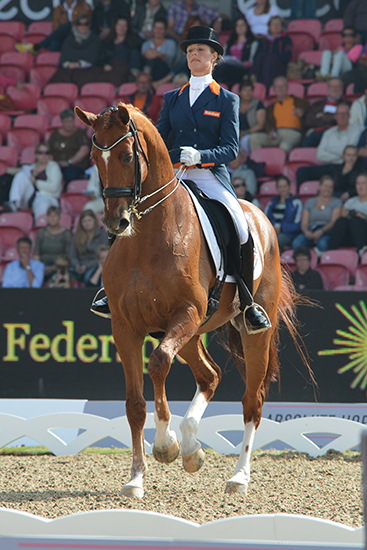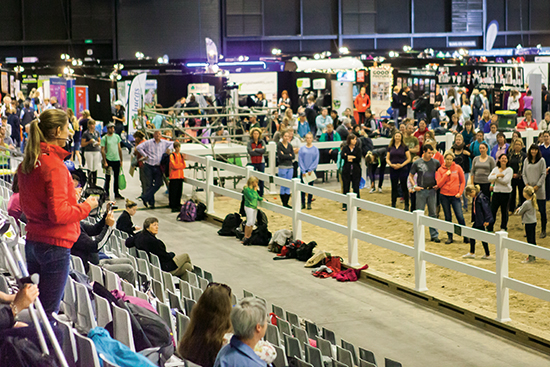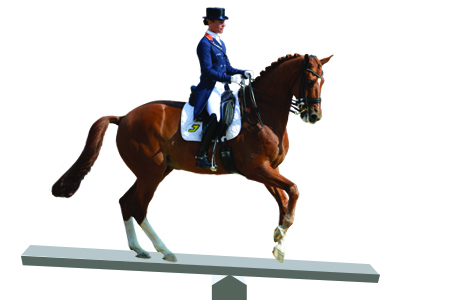 The Olympic silver medalist explains why being fit to ride is non-negotiable
The Olympic silver medalist explains why being fit to ride is non-negotiable
Story by Rebecca Ashton , and Photos by Rebecca Ashton and Roz Neave
The Netherlands has been one of the most progressive dressage countries in recent years. Where Anky showed us how to ride a Kür, Adelinde is spearheading rider fitness like no one else. So much so, that the Dutch Equestrian Federation has now made it compulsory for a third of the training of new equestrian coaches to be in the area of rider fitness. Adelinde also now has her own online training centre where anyone can get to know her fitness methods.
Adelinde explains, “The physical fitness work is really, really important. You owe it to your horse. You don’t want to be the weakest link. You expect your horse to be in top-shape every day of the year but if you’re not, then that’s not fair. I get cross when non-horsey people think the horse does all the work, but when you look at some riders, why would they not think that? If you tell people what you do for your horse, the list is long. And for yourself? Nothing? That’s not right”
“It’s changed me tremendously. Big, big, big changes. You start to be aware of your own body and what muscles you actually use and how you use them. It’s so funny because I said to a couple of riders in the clinic, ‘Relax your upper legs. Just sit.’ Then they’re like, ‘Oh, this is so much easier!’ But that’s just being aware of your own body and what it’s doing. Where do I have tension? Where do I relax? How do I get this position without tensing up. That’s just so, so good.”
Adelinde’s system isn’t about going to the gym and running on the treadmill or using the rowing machine and wearing yourself out. She believes riders should be fit for their sport. “Your body needs to be as quiet as it can be so the horse can pick up the small signals. You need a certain tension in your body, a core stability, but not tightness. Both horse and rider need relaxation first, but it’s not your end goal. You need the perfect tension in the right muscles”
“If you train your own body, you realise how training affects your horse’s body. That’s really important. You realise that your horse’s muscles cannot keep going on forever. What you see happen a lot is that riders keep on going forever and ever and ever because the exercise doesn’t go right so they keep going with it and it gets worse and worse. People don’t seem to realise that it’s getting worse because the horse is getting tired!”
The Dutch champion got serious about her fitness two years ago, “When I came into the Olympic squad, I thought I really have to do something, not just for myself but for my horse.”
Tjalling van den Berg, Adelinde’s fitness coach is based in northern Holland about 1.5 hours away from her. He told her she could come every Wednesday between 11:30-13:30. Adelinde continues, “This was hard because of my commitments but he said time doesn’t count, think about your priorities!” Tjalling, who used to train the Dutch gymnastic team, is not one to mess with. The only answer was, “Yes, sir!” and it is definitely worth the effort. He’s a tough man but also a generous one and utterly passionate about what he does. When Adelinde asked him what he wanted in return he said, “If you win a gold medal in London, I want a thank you. If not, I don’t want anything.”
The training consists of everything from boxing to ballet, running, trampoline work, work on the balance beam, core stability on the ball and balancing blindfolded. Adelinde enthuses, “I’ve done so many weird things! In two years, not one week has been the same as another. What my trainer constantly does is get me out of my comfort zone and see how I respond to that. You see it is only when you are out of your comfort zone that you start training. If you do what you did, you get what you got!”
Tjalling provides 20 coaches to take Adelinde through the different exercises. There is also a mental coach at the gym who is there for the whole two hours of Adelinde’s training session. He walks around, monitoring the athlete and bringing awareness to the training process. Adelinde explains further, “We don’t sit down and talk about how I feel before a comp. He puts me in situations as I train and asks me how I feel. For example, I might be doing my boxing and he sees me getting my breathing up or stiffening up, so he’s there just making me aware of it and asking me how I feel at that moment. This is really important.”
“It’s like when you are riding, you don’t really have time to think about your own balance or your own breathing. If you look at all the riders, half of them are not breathing or not breathing correctly and breathing way too high. They breathe in then forget to breathe out! That causes them to stiffen up in the shoulders and then the horse starts to get stronger and then the rider starts to stiffen the legs and on and on. Breathing deep and low gets your centre of gravity low and helps you with your balance and then it is easier for your horse to carry you. When you do boxing, you can be aware of your breathing, notice when it gets too high and change it, get more relaxed, get the breathing lower and get more grounded into the core and hence become more stable. Tai Chi, yoga and pilates are great for that as well. If you want your horse to balance, you have to learn to balance yourself.”
The awareness is about the whole body, not just the breathing. If the horse is expected to do piaffe, passage and pirouettes, how can the rider not be in balance?
“It’s important to understand what the horse is feeling. Like on the ballet bar, I did a pirouette and then I realised how hard it is for the horse. If you do a little bit with your upper body to the left or to the right, you totally lose balance. You understand how your balance affects the horse. Then when you are on the horse, you really think about being centred with your upper body, about not leaning to one side because the horse has to correct that all the time,” emphasises Adelinde. This was a really big focus in the riding lessons that she gave. The focus was not just on what the horse was doing and the different movements, but very much the rider position and influence and bringing awareness to how stiff and strong a lot of the riders were, controlling their horse by strength rather than balance and softness.
Adelinde’s favourite exercise is boxing. “I love the boxing. It has so much in common with riding. The co-ordination, the balance, the breathing, the quickness of reactions but then being able to relax again straight afterwards and the mental part of it. You start to realise you can do more than you think you can!”
We also touched on the subject of nutrition. Adelinde elaborates, “That’s also part of it. It’s changed a bit for me. In the mornings I would always eat maybe bread and jam or something but then my nutritionist said I had to write down everything I ate for a week. You start to think twice when you pick up the chocolate! So you skip it, which is good! I can eat everything but of course I have to be aware I’m not eating pizza seven days a week. The whole Summer I was doing a lot of vitamins and lots of fruit. I’ve never drunk alcohol or smoked, so that helps too.”
During Equidays held in Hamilton, New Zealand, where she was the star presenter, the Dutch champion shared some exercises with the crowd. Her first aim was to swap positions with the audience. She made everyone go down into the arena while she stood up in the stands. “The first step is to get out of your comfort zone! Be there and present yourself. Get your energy up! Posture! The way you present yourself is how people are going to see you.”
Then it was time for a few exercises. Here are three Adelinde suggested:
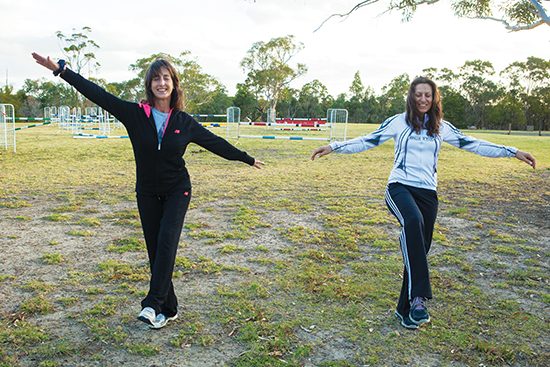 Exercise for balance. Adelinde explained, “When I clean my teeth, I stand on one foot. Now you stand on one foot. How is your balance as a rider? Your horse has to do this in piaffe. Now find a partner and try to push each other over like this. The next step was to try it with eyes closed.
Exercise for balance. Adelinde explained, “When I clean my teeth, I stand on one foot. Now you stand on one foot. How is your balance as a rider? Your horse has to do this in piaffe. Now find a partner and try to push each other over like this. The next step was to try it with eyes closed.
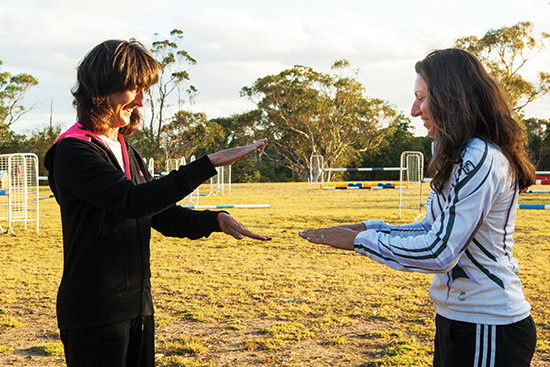 Exercise to test reaction. Two people face each other with their hands out, palms down, fingers touching. One person tries to hit the top of the other person’s hand and the second person tries to pull their hand out of the way before they get hit.
Exercise to test reaction. Two people face each other with their hands out, palms down, fingers touching. One person tries to hit the top of the other person’s hand and the second person tries to pull their hand out of the way before they get hit.
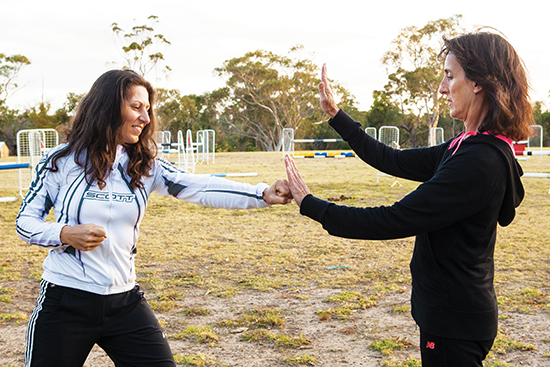 Exercise to test co-ordination. This is a boxing exercise. One person puts their hands up, palms facing out and the other person has to hit them as fast as possible. It tests both people as the one moving their hands around has to come up with all different kinds of combinations to keep the other person thinking, just like you have to do with your horse so he doesn’t anticipate the movements. And when the audience were having too much fun? “Stop laughing! Boxing is about fighting. Really hit their hands hard and fast!” joked Adelinde.
Exercise to test co-ordination. This is a boxing exercise. One person puts their hands up, palms facing out and the other person has to hit them as fast as possible. It tests both people as the one moving their hands around has to come up with all different kinds of combinations to keep the other person thinking, just like you have to do with your horse so he doesn’t anticipate the movements. And when the audience were having too much fun? “Stop laughing! Boxing is about fighting. Really hit their hands hard and fast!” joked Adelinde.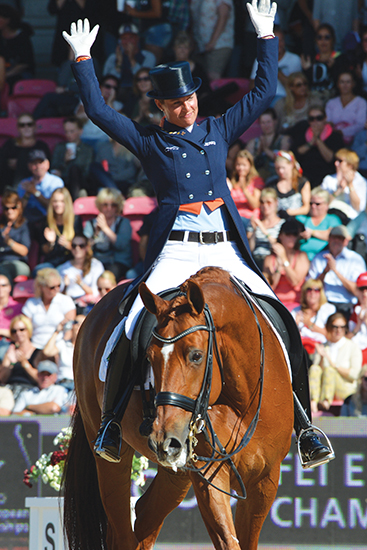
Everyone was made to throw their arms up in a “Y” and yell ‘Winner!’ Adelinde had the crowd feeling great right from the start, “I do this every time I do something good. It changes the energy. Try it! When I get ready to compete I do it in front of the mirror,” and for the rest of the weekend, everywhere you turned there was someone with their arms up yelling, ‘Winner!’ The message was clear: feeling like a winner will help make you a winner.
The session finished with Adelinde encouraging everyone to give three compliments to their partner. “Look straight at them and take their hand. Everyday you have to give 10 compliments to people. This is your homework. Positivity!”
The strong message was that the rider must train as well as the horse. If not, only half the bases are being covered, and in today’s competitive environment where the stakes are higher than ever, this just doesn’t cut it anymore.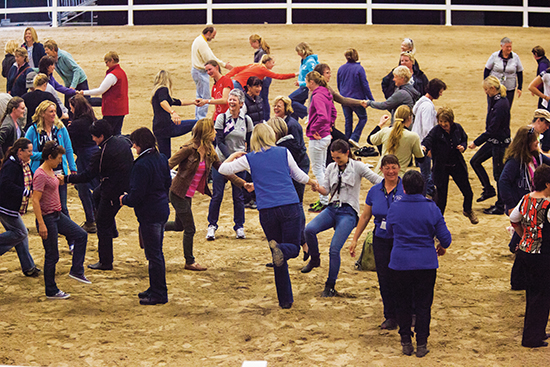
The audience finished energised, happy and focused. Adelinde is a fierce competitor, but also very good fun. She really walks her talk, is vivacious and always looking for new ways to improve her performance. If her fitness and mental attitude is anything to aspire to, no rider out there can afford not to do this work.
For more information on Adelinde’s off the horse training methods, go to: www.adelindetrainingcenter.nl

